Lycoperdaceae
| Agaricaceae Temporal range: Burdigalian–recent |
|
|---|---|
 |
|
| Agaricus campestris | |
| Scientific classification | |
| Kingdom: | Fungi |
| Division: | Basidiomycota |
| Class: | Agaricomycetes |
| Order: | Agaricales |
| Family: |
Agaricaceae Chevall. (1826) |
| Type genus | |
|
Agaricus L. (1753) |
|
| Genera | |
|
85; See text |
|
| Synonyms | |
85; See text
The Agaricaceae are a family of basidiomycete fungi and include the genus Agaricus, as well as basidiomycetes previously classified in the families Tulostomataceae, Lepiotaceae, and Lycoperdaceae.
The family Agaricaceae was published by French botanist François Fulgis Chevallier in 1826. It is named after the type genus Agaricus, originally circumscribed by Carl Linnaeus in his 1753 work Species Plantarum. In his authoritative 1986 classification of the Agaricales, Rolf Singer divided the Agaricaceae into four tribes distinguished largely by spore color: Leucocoprineae, Agariceae, Lepioteae, and Cystodermateae. Genera once classified in the families Tulostomataceae, Battarreaceae, Lycoperdaceae, and Mycenastraceae have since been moved to the Agaricaceae based on molecular phylogenetics studies. According to a standard reference text, the Agaricaceae contains 85 genera and 1340 species.
Agaricaceae species use a wide variety of fruit body morphology. Although the pileate form (i.e., with a cap and stipe) is predominant, gasteroid and secotioid forms are known. In pileate species, the gills are typically thin, and free from attachment to the stipe. Caps are to smooth, and range from roughly flat to umbonate. They typically have a centrally attached stipe and a membrane-like partial veil. The species from classified in the family Lycoperdaceae are also known as the "true puffballs". Their fruiting bodies are round and are composed of a tough skin surrounding a mass of spores. When they mature, the skin splits open and they release their spores.
...
Wikipedia
